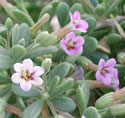Birds
Here, some of the more likely species are listed. Seasonal occurrence: (S)ummer, (F)all,
(W)inter, (Sp)ring
- Great-Tailed
Grackle -- Quiscalus mexicanus -- S,F,W,Sp
- Abert's
Towhee -- Pipilo aberti -- S,F,W,Sp
- Red-winged
Blackbird -- Agelaius phoeniceus -- W, Sp, Su, F -- most common in winter
- Yellow-headed
Blackbird -- Xanthocephalus xanthocephalus -- W,Sp --
- Anna′s
Hummingbird -- Calypte anna -- S,F,W,Sp --
- Verdin --
Auriparus flaviceps -- S,F,W,Sp
- Mourning
Dove -- Zenaida macroura -- S,F,W,Sp
- Northern
Mockingbird -- Mimus polyglottos -- S,F,W,Sp
- House
Finch -- Carpodacus mexicanus -- S,F,W,Sp --
- European
Starling -- Sturnus vulgaris -- S,F,W,Sp --
- Curve-billed
Thrasher -- Toxostoma curvirostre -- S,F,W,Sp --
- Killdeer
-- Charadrius vociferus -- S,F,W,Sp
- American
Coot -- Fulica americana -- S,F,W,Sp --
- Black-tailed
Gnatcatcher -- Polioptila melanura -- S,F,W,Sp --
- Ruby-crowned
Kinglet -- Regulus calendula -- F,W,Sp
- Black
Phoebe -- Sayornis nigricans -- S,F,W,Sp
- Say's
Phoebe -- Sayornis saya -- Sp,F,W
- Cactus
Wren -- Campylorhynchus brunneicapillus -- S,F,W,Sp
- Cliff Swallow -- Sp,S
- Northern Rough-winged Swallow -- Sp,F
- Common
Raven -- Corvus corax -- W --
- Pied-billed
Grebe -- Podilymbus podiceps -- S,F,W,Sp
- Black-necked
Stilt -- Himantopus mexicanus -- S,F,Sp
- American
Avocet -- Salpinctes obsoletus -- S,F,Sp --
- Double-crested
Cormorant -- Phalacrocorax auritus -- S,F,W,Sp --
- Green Heron
-- Butorides virescens -- S,F,W,Sp
- White-faced
Ibis -- Plegadis chihi -- S,F,W,Sp
- Great Blue
Heron -- Ardea herodias -- S,F,W,Sp
- Turkey
Vulture -- Cathartes aura -- S,F,W,Sp -- rare in winter
-
Neotropic Cormorant -- Phalacrocorax brasilianus -- Sp,Su,F
- Brown-headed
Cowbird -- Molothrus ater -- S,F,W,Sp --
- Peach-faced
Lovebird -- Agapornis roseicollis -- S,F,W,Sp
- Inca
Dove -- Columbina inca -- S,F,W,Sp --
- Rock
Pigeon -- Columba livia -- S,F,W,Sp --
- White-winged
Dove -- Zenaida asiatica -- Sp,S
- Gambel's
Quail -- Callipepla gambelii - S,F,W,Sp
- Gila
Woodpecker -- Melanerpes uropygialis - S,F,W,Sp
- Least
Sandpiper -- Calidris minutilla -- S,F,W
- Long-billed
Dowitcher -- Limnodromus scolopaceus -- S,F,W
- Greater Yellowlegs -- S,F,W
- Mallard --
Anas platyrhynchos - S,F,W,Sp -
- American
Wigeon -- Anas americana - F,W,Sp -
- Ring-necked
Duck -- Aythyla collaris -- F,W,Sp
- Canada
Goose -- Branta canadensis - S,F,W,Sp - more abundant in winter
- Ruddy
Duck -- Oxyura jamaicensis -- F,W,Sp
- Northern
Pintail -- Anas acuta -- F,W,Sp
- Northern Shoveler -- F,W,Sp
- Green-winged Teal -- Anas crecca -- F,W,Sp
- Cinnamon Teal -- Su,F,Sp
- Blue-winged Teal -- F,W,Sp
- Black-bellied
Whistling-Duck -- Dendrocygna autumnalis -- Su,F
- American
Kestrel -- Falco sparverius -- S,F,W,Sp
- Red-tailed
Hawk -- Buteo jamaicensis -- S,F,W,Sp
- Loggerhead
Shrike -- Lanius ludovicianus -- F,W,Sp
- Osprey -- F,W,Sp
- Great-horned Owl -- S,F,W,Sp
- Snowy
Egret -- Egretta thula -- Sp,S,F
- Black-crowned Night-Heron -- Nycticorax nycticorax -- S,F,W,Sp --
- Lesser
Goldfinch -- Carduelis psaltria -- S,F,W,Sp --
- White-crowned
Sparrow -- Zonotrichia leucophrys -- F,W,Sp
- Song Sparrow -- F,W,Sp,S
- Brewer's Sparrow -- F,W,Sp
- Chipping Sparrow -- F,W,Sp
- Western Meadowlark -- F,W,Sp
- Blue Grosbeak -- Sp,F
- Great
Egret -- Ardea alba -- Sp,S,F
- Vermilion
Flycatcher -- Pyrocephalus rubinus -- W,Sp
- American
Pipit -- Anthus rubescens -- W, Sp
- Sora
-- Porzana carolina -- F,W,Sp
- Yellow-rumped Warbler -- F,W,Sp
- Lucy's
Warbler -- Vermivora luciae -- Sp,F
- Orange-crowned Warbler -- F,W,Sp
- Wilson's Warbler -- F,W,Sp
- Yellow
Warbler -- Dendroica petechia
- Wilson's Snipe -- F,W,Sp
- Gadwall -- S,F,W
- Redhead -- F,W
- Cattle Egret -- Su,F
- Red-shafted Flicker -- W, Sp
|
Sponsored Link(s)
|







































